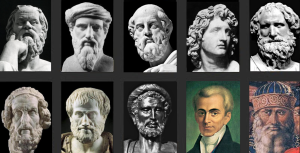
Philosopher (c.600 BC – c.520 BC)
Pherecydes was a pre-Socratic philosopher, poet and mystic from the island of Syros, as well as teacher of Pythagoras, who flourished during the 6th century BC, regarded as the first Greek writer to write in prose in recorded Greek literature. His work, influenced by Orphic thought, deals with cosmogony and recounts some of the earliest descriptions on the creation of the Universe based on the ancient Greek mythos, which he attempted to rationalize.
Pherecydes, a contemporary of philosophers Thales and Anaximander, was student of Pittacus, one of the Seven Sages of antiquity, although to a large extent an autodidact. He founded his own school in Samos, where Pythagoras became his student. Indeed, Pherecydes exerted significant influence to Pythagoras and is said that when he died, Pythagoras was the one who buried him in Delos, the birthplace of Apollo.
His book Pentemychus or On the Nature of Gods is perhaps his most well known surviving treatise. This book is an esoteric interpretation of the creation of the Universe. It consisted of ten different tomes. It furthermore delved into the nature of the primordial deities and their genealogy. It is likely that he used Hesiod’s Theogony as a guidebook.
According to Pherecydes, in the beginning, there were Zeus, Time and Chthonie, the three eternal beings, which gave birth to the existing world. On the third day of Zeus’ and Chthonie’s marriage, Zeus bestowed Chthonie a veil, created by Time, on which were embroidered the Earth and the Ocean. This veil covered a floating oak tree. This and numerous other myths recounted by Pherecydes serve as allegories to his philosophy on the creation of the world, the transmigration of souls and the principles that govern the physical world. He was the first to personify Time, which was later incorporated in the figure of Cronus (Saturn).
As one of the earliest recorded thinkers in Greek history, Pherecydes’ philosophical logos helped shape Pythagoreanism and influenced important thinkers after him, such as Aristotle and Plutarch. His teachings are also said to have reached Egypt, where they became quite popular.
Bibliography:
- Λεκάκης, Γεώργιος. Ὁ Ὀρφικὸς Φιλόσοφος Φερεκύδης, απὀ τὴν Σῦρο, διδάσκαλος τοῦ Πυθαγόρα. Ἀρχεῖον Πολιτισμοῦ. http://www.arxeion-politismou.gr/2022/01/orfikos-Ferekydis.html
- Φερεκύδης. Νεότερο Ἐγκυκλοπαιδικό Λεξικό τοῦ Ἡλίου. Ἀθῆναι: 1952.
- Stamatellos, Giannis. Pherecydes of Syros. Available at: https://www.philosophy.gr/presocratics/pherecydes.htm







